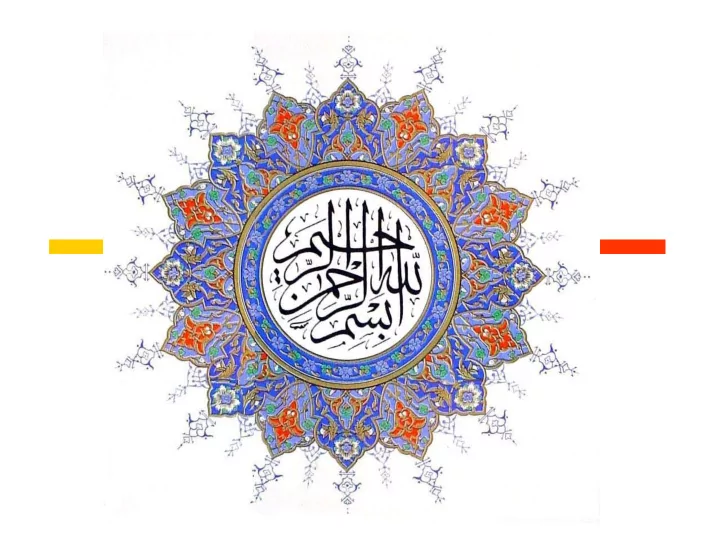

In the name of Allah In the name of Allah the compassionate, the merciful
Digital Video Processing S. Kasaei S. Kasaei Room: CE 307 Department of Computer Engineering Sharif University of Technology E-Mail: skasaei@sharif.edu Web Page: http://sharif.edu/~skasaei http://mehr.sharif.edu/~ipl
Chapter 4 Chapter 4 Video Sampling Rate Video Sampling Rate Conversion Conversion
Sampling Rate Conversion � Sometimes it is required to display: � A PAL signal on an NTSC TV system. � A motion picture on film on PAL TV broadcasting. � Made-for-TV material on a computer screen, which uses progressive display (an interlaced raster into a progressive raster known as deinterlacing ). � An MPEG2 video on a mobile phone (H263). � A H.263 video format on H.264/MPEG4 devices (transcoding). Kasaei 5
Conversion of Signals Sampled on Different Lattices � Once in the digital domain, we often need to convert a digital video signal from one format (in terms of spatial & temporal) to another (from one lattice to another). � The solution depends on the relation between two lattices. � This leads to up-conversion (interpolation) or down-conversion (decimation), or both. Kasaei 6
Conversion of Signals Sampled on Different Lattices � For up-conversion, we first zero-pad the lattice points & then estimate the values of new points by interpolation. � For down-conversion, to avoid aliasing, we need to pre-filter the signal to limit its bandwidth to the Voronoi cell of the reciprocal of the new lattice. � For arbitrary rate conversion, the third lattice contains both lattices & the filter fulfills both interpolation & spectrum limitation. Kasaei 7
Conversion of Signals Sampled on Different Lattices Kasaei 8
UP-Conversion Kasaei 9
Down-Conversion Kasaei 10
Kasaei 11
Sampling Rate Conversion General procedure includes: � 1. Determining the equivalent sampling lattices of the input & output signals, & an intermediate lattice that covers the samples in both signals. 2. Determining the desired filter frequency response (based on the Voronoi cells of the three lattices). 3. Designing a filter that approximates the desired response. Kasaei 12
Sampling Rate Conversion In practice to reduce the computational � complexity one can: Use very low-tap filter (specially in the � temporal direction). Decompose spatiotemporal conversion � problem into spatial conversion followed by temporal conversion (or vise versa). Kasaei 13
Deinterlacing Kasaei 14
Kasaei 15
Deinterlacing � Practical interlacing: � Uses simpler filters. � Vertical interpolation (averaging) within the same field (line averaging). � To improve the performance, longer vertical interpolation filters can be used. � A simple temporal interpolation is field merging (that just copies the corresponding line from the top/bottom field). � To improve the performance, a symmetric filter can be used (field averaging). � To achieve a compromise between the spatial & temporal artifacts, both vertical & temporal interpolations are used (line & field averaging). Kasaei 16
Kasaei 17
Conversion between PAL & NTSC Signals � For direct conversion, because of the very complicated shape of the reciprocal Voronoi cells, the filter is not easy to design. � In practice, the problem is more often solved in several sequential steps. Kasaei 18
Kasaei 19
Conversion between PAL & NTSC Signals Kasaei 20
Kasaei 21
Kasaei 22
Conversion between PAL & NTSC Signals Kasaei 23
Conversion between PAL & NTSC Signals Kasaei 24
Conversion between PAL & NTSC Signals Kasaei 25
Motion-Adaptive Interpolation � In stationary regions, temporal interpolation yields an accurate result. � In regions undergoing rapid temporal changes, same spatial indices may correspond to different object regions. � In this case, spatial interpolation alone is better (no temporal interpolation). � To overcome such problems, motion- adaptive interpolation filters can be used. Kasaei 26
Motion-Adaptive Interpolation � With such a filter, one switches between vertical & temporal interpolation at each pixel, depending on the output of a motion detector (motion � vertical interpolation). � Motion detection can be performed locally. � To further improve the performance, motion-compensated interpolation can be investigated. Kasaei 27
The End
Recommend
More recommend